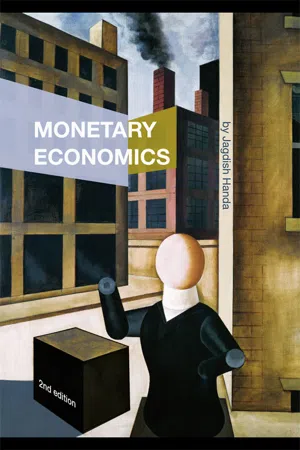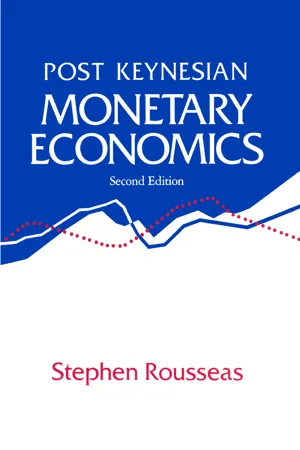Demand in the Loanable Funds Market
Demand in the loanable funds market represents the quantity of funds that borrowers are willing to borrow at various interest rates. As interest rates decrease, the demand for loanable funds increases because borrowing becomes more affordable. This relationship is illustrated by the downward slope of the demand curve in the loanable funds market.
4 Key excerpts on "Demand in the Loanable Funds Market"
- eBook - ePub
- Jagdish Handa(Author)
- 2008(Publication Date)
- Routledge(Publisher)
...The supply of money depends on the monetary base and the inside money created by financial intermediaries. The overall supply of funds in period t is the net new supply from the above two sources plus: (iii) Funds becoming available from loans that have matured in period t. The flow demand for loans is from net new borrowers and those who wish to renew existing loans. The net new demand for loans comes from: (iv) Current investment in the economy. (v) Bond-financed government deficits. 7 The flow demand for loans in period t is from (iv) and (v), plus: (v) Demand for credit from those whose loans have matured. Assuming (iii) and (vi) to be equal, the loanable funds theory in flow terms specifies the real demand (f d) and supply (f s) functions of loanable funds as: (19) (20) where: f s = real flow supply of loanable funds (demand for bonds) f d = real flow demand for loanable funds (supply of bonds) s = real saving i = real investment g = real government expenditures t = real government revenues M0 s = supply of the nominal monetary base θ = monetary base to money supply multiplier (= ∂ M s /∂M 0) m d = demand for real balances P = price level. We have assumed that the government deficit. (g − t) is wholly bond-financed and that r and R are related by the Fisher equation. In partial equilibrium analysis, the equilibrium value of the market rate of interest is determined by: (21) Note that the left side of (21) represents the demand for bonds and the right side represents the supply of bonds. (21) is the statement that the interest rate is determined by the equilibrium in the flow part of the bond market. Long-run determination of the interest rate Equation (21) specifies the determination of the short-run interest rate and shows that, although the interest rate is determined by the excess demand for loanable funds, it is not independent of the excess demand for money: 8 excess money demand raises the interest rate and excess money supply lowers it...
- eBook - ePub
Macroeconomic Theory: A Short Course
A Short Course
- Thomas R. Michl(Author)
- 2015(Publication Date)
- Routledge(Publisher)
...If our income goes up, we will spend more on consumer goods and therefore we will need to have liquidity available in the form of cash or a checking account balance. The interest rate affects our demand for money because any wealth held in money form cannot earn interest. The interest rate is the opportunity cost or penalty for holding wealth in liquid form. Because the interest rate is the cost of liquidity, we will desire less money and more bonds in our optimal portfolio as the interest rate increases. This is the asset motive, or speculative motive for holding money, and this part of the demand for money is called the speculative demand. (We will explain why the peculiar term speculative is used later.) In general, the demand for money is written as a function M d = PL (Y, i) where PY represents nominal income. The symbol L derives from the fact that this function describes the demand for liquidity, and this approach to asset markets is called the theory of liquidity preference. The simplest linear form of the demand for money is M d = P (d 1 Y − d 2 i) The price level appears outside the parenthesis in conformity with economic theory. If prices double (say), the demand for money should also double. The parameters d 1 and d 2 will be called the income sensitivity and the interest sensitivity of the demand for money. According to economic theory, their values depend on the underlying preferences of the households and on institutional details of business organizations and the financial system. The demand for money in real terms is also called the demand for real balances. By simply rearranging terms in the linear demand for money, it is written (5.1) M d P = d 1 Y − d 2 i It turns out to be much easier to work with the demand for and supply of real balances. When economic agents choose a demand for money, they also choose the velocity of money. For example, under Equation (5.1), the velocity of money would be defined by V = PY/M = Y /(d 1 Y − d 2 i)...
- eBook - ePub
- Milton Friedman(Author)
- 2017(Publication Date)
- Routledge(Publisher)
...7 Interest Rates and the Demand for Money O NE MAJOR STRAND of Keynesian analysis traces the implications of a particular empirical assumption about the demand for money—that its elasticity with respect to interest rates is very high, approaching infinity (in Keynes’ own terms, liquidity preference is, if not absolute, approximately so). Such a situation would have very far-reaching implications: it would greatly limit the effectiveness of price flexibility in correcting unemployment; it would render changes in the quantity of money produced by open market operations impotent to affect economic conditions; it would make the effect of government deficits on income and employment independent of the way in which the deficits are financed. By now, there is wide agreement that conditions of near-absolute liquidity preference, if they occur at all, are very rare, so that this strand of Keynesian analysis has receded to the status of a theoretical curiosity. More recently, a number of economists have attributed major theoretical importance to the opposite empirical assumption about the demand for money—that its elasticity with respect to interest rates is negligible. Such a situation, they assert, would have far-reaching implications for the theoretical possibility of separating monetary and real forces and for monetary policy. Like Keynes’ analysis, these assertions raise two separable issues...
- eBook - ePub
- Rousseas(Author)
- 2016(Publication Date)
- Routledge(Publisher)
...It is dependent mostly on the level of economic activity in nominal terms (Y). In the Treatise the parameters for this demand function, as we have seen, were: (1) the character of production, (2) the habits of the public and the business world, and (3) the opportunity cost of holding cash balances, i.e., the interest income foregone. A fourth parameter should also be added to the three cited by Keynes, namely, (4) the underlying institutional structure of the financial sector of the economy and its stability, i.e., the absence of rapid financial innovations. Assuming all four to be constant, then the demand for transactions balances is determined by the current pace of production in the industrial sector, or L 1 = L 1 (Y). In the Treatise, however, Keynes explicitly allowed the demand for "cash deposits" to respond to the rate of interest: "[W]hen business is active and the cost of borrowing high, firms will tend to economize in the amount of Business-deposits A which they keep" (italics supplied); that is, the velocity of circulation of Business-deposits A will rise. In the General Theory, Keynes toned this down to a "first approximation" in which L 1 is completely inelastic with regard to the rate of interest. The rate of interest was reserved for the dominant role it was to play in the L 2 demand function for idle balances held as a store of wealth—within which the financial sector of the Treatise was now to be found. The L 1 demand for money is shown in Figure 3.2 as a straight line through the origin with nominal income (Y) on the vertical axis and the demand for transactions, or active, balances (L 1) on the horizontal axis. The tangent of angle a is Y/L 1, which can be written as Y/M 1 since the transactions demand for money has priority over the L 2 demand for idle balances and is the first to be satisfied out of a given exogenous money supply—with the residual, M 2, remaining to satisfy the L 2 demand for speculative balances...



